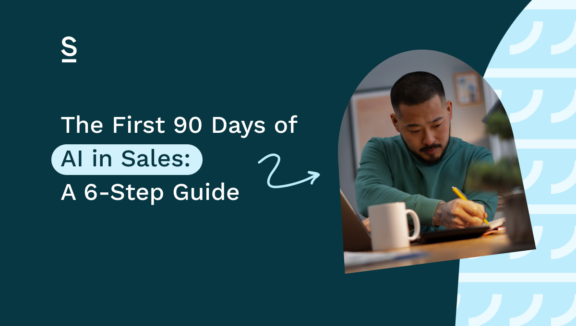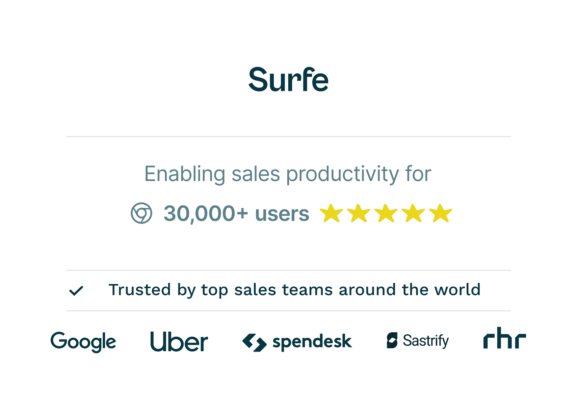The First 90 Days of introducing AI in Sales: A 6-Step Guide

Introducing AI to your working life is unavoidable in this day and age.
In other words, AI will give you the best chance of sales success. But there is a teeny-tiny catch: you’ve got to set it up properly from the very beginning.
Skip this bit, and you’re basically pulling off the digital equivalent of putting your socks on over your shoes. Sure, you may get to where you want to go, but it’s not going to feel very comfortable (and you’ll probably look a bit weird, too. No offense).
Now, the last thing we want you to do is look weird – so we’re going to break down the first 90 days of AI in sales into six practical steps:
- Step 1: Figure Out Why You Even Want Or Need To Use AI
- Step 2: The Big Decision: Selecting The Right AI Tools And Platforms
- Step 3: Get Your Team Comfortable Using AI
- Step 4: Start Small But With Big Ambitions
- Step 5: Tracking: Did It Make An Impact?
- Step 6: It’s Time To Scale Your AI Integrations
Follow these steps carefully, and you’ll transform your sales processes with AI. Need we say any more?
Didn’t think so. Let’s get going.
Step 1: Figure Out Why You Even Want Or Need To Use AI
We hate to break it to you, but “Everyone else is using it” isn’t a great reason to start using AI.
As with any new tool or technology, AI works best when it’s tied to clear goals. Without them, the results will likely fall short.
So, how do we get there?
First up, you want to identify your biggest sales challenges. Maybe your leads take ages to respond, maybe the difference between your forecasts and reality is night and day, or maybe prospecting is taking over your team’s lives.
Next, what’s a milestone that would show you’ve solved – or at least reduced – the size of the challenge? To take the examples above, this could be shorter lead response times, getting to 90% of target, or reducing time on admin.
Key questions to ask yourself: what are the bottlenecks in our current sales process? How will AI help us meet our goals faster or more effectively?
Key metrics to track: lead conversion rates, time saved on manual processes.
Step 2: The Big Decision: Selecting The Right AI Tools And Platforms
Pick the right tool for your needs, and your introduction to AI will be a breeze. Pick the wrong tool, and…it’ll be the opposite. We’re not just talking about picking the best AI tool out there, by the way – it’s all about picking something that yes, is good (duh), but also fits in with your team’s needs and the tools you’re already using.
Start off by researching tools that integrate with your CRM and current tech stack. You’ll want to consider how easy they are to use, how scalable they are, and what kind of analytics and reporting they provide.
Don’t rush your research – if a tool you’re considering offers a demo or a trial, jump on these. Try before you buy, and you can’t go too far wrong.
Key questions to ask yourself: Does the platform address our specific pain points? Is it user-friendly enough for our team to adopt quickly? Can it grow with our business?
Pro tip: things like built-in support and training resources to make onboarding smoother make all the difference. Don’t forget about them – no matter how cool the tool is.
Step 3: Get Your Team Comfortable Using AI
Even the best AI tools won’t make an impact if your team isn’t using them confidently. Think about it like wearing a pair of novelty socks over an ultra-cool pair of trainers: you may as well not bother.
Building trust from the very beginning is key. Schedule AI training sessions as soon as you’ve set the tool up, so the entire team knows how to use it effectively. It’s worth noting that some roles may have listened to the rumors of AI stealing our jobs – make sure you explain that AI’s there to assist, not to replace. Now would be the moment to share a success story from another sales team, or from your own experience.
Tips for overcoming resistance: don’t beat around the bush. Address fears – like concerns about job replacement or tool complexity – head on. We’re sure your team will want to hear about how this AI tool is going to cut down on admin, and leave them to focus on the good stuff, too.
Basically, you want to aim for AI adoption being a team effort. Show how it enhances roles, rather than complicates them, and you’ll have everyone on board in no time.
Step 4: Start Small But With Big Ambitions
Got an enormous, multi-faceted problem you need to solve – for example, accurately predicting revenue growth and resource allocation? Don’t start your AI journey with that.
Instead, launch it on smaller-scale problems – you’ll be able to experiment, learn, and refine before rolling it out to the entire team.
Start off by choosing a specific team, region, or sales process (you’ll know better than us what makes most sense for your business). Now, how can you make the pilot program even smaller? Could you focus on one or two key problems, like lead prioritization or personalizing email campaigns, for example?
Gather feedback as you go: the sooner you can make changes, the more likely your chances are of success. From there, you can scale to those big, meaty problems.
Metrics to measure success: improved lead response times, percentage of tasks automated, increased engagement or conversions from AI-driven actions.
Think of your pilot program as a testing ground for success – learn from it, and use the insights to scale up confidently.
Step 5: Tracking: Did It Make An Impact?
Sending your AI pilot program out into the world without any idea of how it’s doing isn’t very clever. Without it, you’re not going to be able to see what’s going well, and what’s not going so well – and tell your boss whether you’re getting that big return on investment you promised.
Take a look at the metrics you want to keep track of: think pipeline growth, time saved, and revenue generated. Your tool of choice should do all the hard work for you – we’re talking AI analytics that show you trends and give you insights into what’s working, and what’s not.
Schedule regular check-ins with your team to discuss performance and make adjustments as needed. Qualitative feedback can provide insights where the quantitative stuff can’t, after all.
Metrics to focus on: look at things like sales velocity, customer engagement rates, and ROI of the tool itself for a big-picture point of view.
Pro tip: don’t expect perfection right away – optimize based on early data to improve results over time. Patience is key!
Step 6: It’s Time To Scale Your AI Integrations
You’ve introduced a pilot scheme, got your team on board, and proven the value – now it’s time to go big. This is the fun part: you can start exploring new use cases and working on the creative, strategic stuff – after all, AI’s just absorbed most of your admin work.
Expand the use of AI tools to all teams, regions, or sales processes, and integrate it into the areas you need it the most: think more complex efforts like upselling strategies, forecasting, or customer retention efforts.
Commit to ongoing training to keep your team up-to-date, and they’ll start finding and sharing their own AI discoveries too. Revenue growth, here you come!
Now, remember you’ve chosen a tool that can scale with you, by handling larger datasets and higher usage – so no need to worry about that. Continue collecting feedback to refine your efforts as you go along, and enjoy the ride.
Let’s Wrap It Up!
Hey – cool shoes you’ve got there!
Scaling AI is all about building a culture of innovation – embrace new ideas and opportunities to stay ahead, test and learn as you go, and enjoy a level of sales success you’ve never seen before. Make sure to pass on what you learn, ok?

Hey – you know what else can support your AI efforts?
Surfe – you need some prospects to try out your new sales process, after all. Try it here.
FAQs About The First 90 Days of Using AI in Sales
What Are the Benefits of Using AI in Sales?
AI in sales can transform your sales processes by automating time-consuming tasks, like data entry and lead scoring, freeing up your team to focus on selling. Studies show that sales teams using AI experience higher revenue growth compared to those without. Efficiency aside, good AI tools will provide valuable AI analytics and insights to help you track performance and optimize strategies, leading to better customer engagement, faster responses, and increased sales success.
How Do I Choose the Right AI Tools for My Sales Team?
Start by identifying your team’s biggest challenges. This might be lead prioritization or time spent on admin, for example. Look for AI tools that integrate well with your current tech stack, such as your CRM, and prioritize features like scalability, ease of use, and detailed reporting. Don’t rush the process – take full advantage of trial periods to make sure the tools meet your needs. Prioritize offerings with built-in training and support to make onboarding smoother. The right tool will not only address your pain points but also fit your team’s workflow nice and easily.
How Can I Help My Sales Team Get Comfortable Using AI?
The key to AI adoption is building trust and providing training. Organize workshops early on to teach your team how the tools work and emphasize that AI is here to assist, not replace, their roles. Address any concerns – like fears of job loss or tool complexity – directly. Now is not the time to beat around the bush! Share success stories from other teams to highlight the potential benefits, like reduced admin work and improved sales performance. By showing how AI simplifies work, you’ll make adoption a team effort.
What Metrics Should I Track to Measure AI’s Impact in Sales?
Tracking AI’s success starts with defining the right metrics. The right metrics will be unique to your business, but you might want to focus on stats like pipeline growth, time saved on manual tasks, and revenue generated. You could also look at lead response times, conversion rates, and sales velocity for a deeper dive into AI’s effectiveness. Your AI tool should provide analytics to help you spot trends and opportunities for improvement. Combine these insights with qualitative feedback from your team to refine your strategy and maximize ROI over time.
Why Is It Important to Start Small When Implementing AI in Sales?
Launching AI on a smaller scale helps you experiment and learn before rolling it out to your entire team. Start with a specific process, team, or region – like personalizing email campaigns or improving lead prioritization, for example. This approach allows you to refine the tool’s usage and gather feedback early on, minimizing risks. Once you’ve proven success, you can confidently scale AI to tackle more complex challenges, like forecasting or customer retention.


